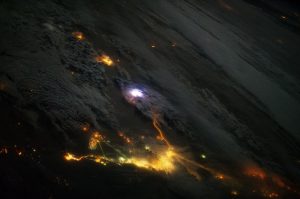30 March 2017
Lightning could be sending powerful electromagnetic radiation into space
Posted by Lauren Lipuma

Lightning flashes in storm clouds over Earth in a photograph taken from the International Space Station on December 12, 2013. Satellites orbiting Earth can pick up trans-ionospheric pulses from cloud-to-ground lightning during storms like this.
Credit: NASA/Expedition 38 crew.
By Alexandra Branscombe
During a thunderstorm, lightning that hits the ground may be shooting powerful electromagnetic radiation skyward. At least that is the new theory from a physicist in China who specializes in laser-plasma interactions.
Hui-Chun Wu, who works at the Institute for Fusion Theory and Simulation (IFTS) and Department of Physics at Zhejiang University, has developed a new theory connecting lightning to a mysterious atmospheric event: trans-ionospheric pulse pairs.
Trans-ionospheric pulse pairs, also called TIPPs, are the most powerful natural electromagnetic signals on the planet. TIPPs were first discovered more than two decades ago by satellites. Although they have been connected to thunderstorms, researchers are still looking for their source.
TIPPs are comprised of two electromagnetic pulses at a frequency above 25 megahertz. These pulses are invisible to humans but can be detected by satellites. Previous research has suggested TIPPs are generated by a single lightning source within the storm clouds, with the first pulse traveling directly into the sky to be picked up by satellites, and the second pulse traveling towards Earth before it echoes off the ground and shoots back into space.
In a new study in Geophysical Research Letters, a journal of the American Geophysical Union, Wu suggests TIPPs originate from two independent sources in one lightning strike hitting the Earth. GPS satellites may be able to use the pulses to monitor large storms and potential human hazards in real time, he said.
The new study suggests that as lightning streaks toward the ground from storm clouds, electrons accelerate from the tip of a “stepped leader,” a negatively charged channel coming down from the clouds in multiple steps. During the acceleration process, the electrons multiply rapidly, said Wu. The electrons from the last two “steps” of the lightning strike the ground to produce the two pulses, or TIPPS, which travel directly into space.
To study the characteristics of the pulses, Wu used a model of TIPPs data recorded from satellite detectors combined with information about the energy, electron number, and length of electron bunches released from lightning. From the model, Wu could derive the intensity of the TIPPs signals, as well as their duration, pulse intervals, and other characteristics, and compare it to the bunches of electrons from lightning strikes.
Wu’s model shows that the interval between the two pulses and duration of each pulse is directly equal to those of the electron bunches released in a lightning strike steps, suggesting lightning to be the source of the TIPPs.
Wu discovered his theory while working on research on ball lightning, a spontaneous ball of fire that can occur near the ground or inside an aircraft. His interest in ball lightning started when he read a recently published paper on the subject and considered that this natural phenomenon could be connected to electromagnetic radiation. His research into ball lightning led him to discover TIPPs, which sparked a new idea to research.
“We propose that both TIPPs and ball lightning are caused by energetic electrons from lighting when it strikes the ground or aircraft,” said Wu.
Wu said that future research measuring the electromagnetic signals coming from cloud-to-ground lightning would be the next step in confirming his theory.
— Alexandra Branscombe is a freelance science writer. Follow her on twitter at @alibranscombe.


 GeoSpace is a blog on Earth and space science, managed by AGU’s Public Information staff. The blog features posts by AGU writers and guest contributors on all sorts of relevant science topics, but with a focus on new research and geo and space sciences-related stories that are currently in the news.
GeoSpace is a blog on Earth and space science, managed by AGU’s Public Information staff. The blog features posts by AGU writers and guest contributors on all sorts of relevant science topics, but with a focus on new research and geo and space sciences-related stories that are currently in the news.